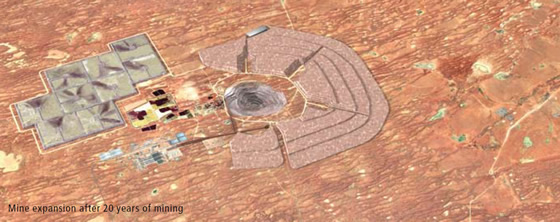The final environmental report for the expansion of the Olympic Dam project has been submitted as per schedule by BHP Billiton. This keeps the project on track for a final approval to be given in the latter half of next year.
The Olympic Dam project is located in the outback in South Australia. It is the world’s largest uranium deposit and the fourth largest copper resource. The mine has been in production since 1988 and BHP Billiton now wants to realize its full potential.
This would involve expansions which would be the single largest investment that BHP Billiton has made in Australia. The expansions are subject to final approvals from the South Australian, Northern Territory and Federal governments.
The proposed expansion is centred on the creation of a new open pit mine that would operate simultaneously with the existing underground mine and lift ore production six-fold to the levels shown below. The existing smelter would be expanded and new concentrator and hydrometallurgical plants would be built to process the additional ore, and generate additional concentrate for transport.
 Mine expansion after 20 years: Image Credit: BHP
Mine expansion after 20 years: Image Credit: BHP
Infrastructure
The major items of infrastructure required to support the expansion of mining and minerals processing would include:
- a 280 megalitre per day (ML/d) coastal desalination plant at Point Lowly on Upper Spencer Gulf (to supply 200 ML/d of additional water via a 320 km pipeline connection to Olympic Dam and with the potential to
supply 80 ML/d for the South Australian Government to replace River Murray water to Upper Spencer Gulf and Eyre Peninsula regions)
- either an additional 270 km electricity transmission line from Port Augusta to Olympic Dam, or a gas pipeline from Moomba and a new gas-fired power station at Olympic Dam, or a hybrid solution that is a combination of these two supply methods
- a 105 km rail line to connect Olympic Dam to the national rail network near Pimba, to move product and supplies predominantly by rail instead of road
- a new airport to replace the existing airport at Olympic Dam. The new airport would handle aircraft such as the Boeing 737-800 or A320 and would support both day and night flights
- a landing facility 12 km south of Port Augusta to unload equipment from barges, and an access corridor to a pre-assembly yard on the north-western outskirts of Port Augusta
- additional port facilities in South Australia at Outer Harbor and in the Northern Territory at the Port of Darwin to import supplies and export product
- a new accommodation village for workers (named Hiltaba Village)
- expansion of the Roxby Downs township, 14 km south of the mine, where most of Olympic Dam’s operational workforce would continue to live.
The gigantic expansion plans will create about 15,000 new jobs and the life of the mine would be increased. The next 30 years of operation will see a revenue increase of $48 billion as well. Little wonder then when the acting Premier Paul Holloway said that there was no project that’s more important for South Australians.
BHP Billiton chief executive Marius Kloppers hopes to take the proposal for the investment to the company board by end of next year if all the approvals have been gained by then.